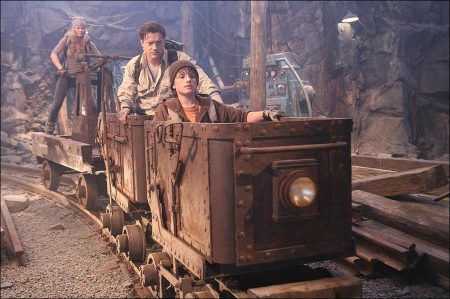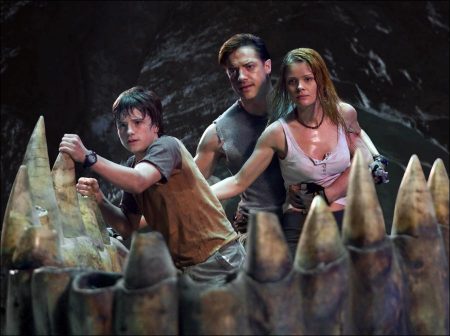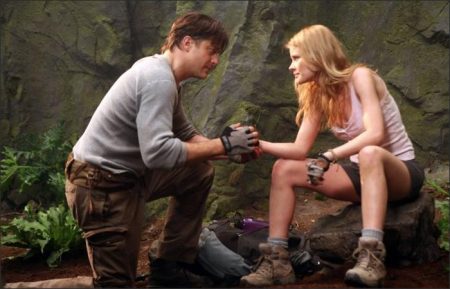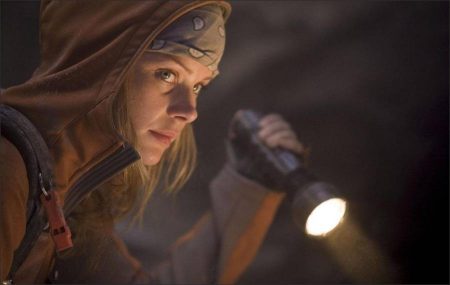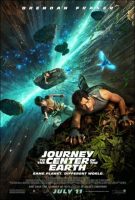Journey to the Center of the Earth Movie Trailer. To capture the scale of sweeping panoramas ranging from the glacial peaks of Iceland to the vast sea at the center of the Earth, and the intricate detail of petrified mushroom forests and calcified rock formations, Brevig called on the expertise of an array of talented artists, including concept lead artist Erik Tiemens, production designer David Sandefur, director of photography Chuck Schuman and visual effects supervisor Christopher Townsend.
“When creating a fantasy story, you’re taking the truth and stretching it,” offers Brevig. “We began with the concept art, which was the touchstone for production design, visual effects and cinematography. The final look in the film is the product of tremendous collaboration by nearly 200 artists.”
In referencing the concept art, Sandefur remarks that one of the greatest challenges was balancing the real and surreal. “There had to be some level of the fantasy, but at the same time, I wanted to try and maintain a level of realism,” he notes. “The texture and color needed to look and feel very real and very rich. And although the audience knows we’re in this fictitious world, I’d like them to think that we went to a location and shot underground or in a jungle.”
“We approached the look of the film using what we called a ‘color script,’ which was a plan for the use of color throughout the movie,” notes Brevig. “At the beginning of the movie, we start in a muted color range, then we take the audience into a heightened color reality once we get to the center and by the end of the film, they return to a more vivid environment to imply that Trevor’s life is brighter and more hopeful.”
Production took place in Montreal, which was hardly jungle-like, but surprisingly, the northern city proved invaluable when it came to set designs, particularly its natural surroundings. “One of the things we found helpful was the access just outside of the city to a phenomenal, organic terrain, which we used to come up with the texture and configurations of our sets,” explains the production designer. “We took molds off of real surfaces in a lot of different areas and made plaster skins out of those and attached them to the walls.”
For the Mushroom House that Trevor, Sean and Hannah find at the center of the Earth, Sandefur remarks, “My team and I spent weeks experimenting with materials to get the surfaces to look just right. After all, what does the inside of a mushroom look like? Can someone get me a few books on interiors of mushroom homes…anyone?”
Sandefur finally decided to use industrial-sized sponges, slicing them into thin slivers and painstakingly lacing them on top of each other to give the surface a porous, organic-looking texture. Once the slivers were bonded together, “we cast surfaces with translucent latex, and then painted and backlit them for a bioluminescent effect,” continues Sandefur. “It’s like being inside a giant Jack-o¬lantern.”
While Sandefur’s team built a rock wall that measured roughly 40-feet high by 30-feet wide, the visual effects team, led by visual effects supervisor Christopher Townsend, extended the wall hundreds of feet down with CGI. To create the visual effects (VFX) shots in “Journey to the Center of the Earth” in 3D, Townsend’s VFX team performed double duty, rendering twice the amount of shots for each of the film’s 726 visual effects shots, resulting in a total of more than 1,400 visual effects shots created.
Townsend explains, “In 3D, what we have to do is recreate the world behind the actor and convey that volume and that space. We have to render a piece of geometry in computer graphics that disappears back just as far as it would disappear back in the real world. So if it’s six miles to the horizon, then within the computer, you have to build a computer model that actually disappears back six miles. You can’t just fake it with a flat painting. You actually have to put it in its correct dimension.”
Making a live-action 3D action adventure film with extensive visual effects that will be added in postproduction requires actors to have active imaginations during principal photography. “They have to be ready to interact with fantastical objects and creatures-glow birds and giant flying piranhas-that obviously aren’t really there,” states Brevig.
The filmmakers tried to make the experience as natural for the actors as possible. “You really hope that the technology is as invisible to the actors as it is to the audience,” notes Huggins. “The cast needs to be focused on their characters and in the story.”
Preparing For the Plunge
For the three leads, working on an action adventure film also meant many intense physical challenges. Hutcherson states, “During the weeks of pre¬production, we went to a really awesome rock-climbing gym to prepare for the scene where we repel down the big volcanic tube.”
“There was a lot of climbing and falling, running and harnessing, which is all great fun,” say Fraser.
Hutcherson picked up a few tricks of the trade from Fraser. “There’s so much big action in this film that, day after day, climbing walls, getting thrown around on ropes and jumping from rock to rock, the physical demands do take their toll. On the first day of filming, I was like, ‘I don’t need knee and elbow pads,’ but after a short while, I learned I was very wrong.”
“After doing three ‘Mummy’ pictures, I’ve gained a full appreciation for the makers of athletic padding,” smiles Fraser. “There’s a reason why my shirt sleeve is rolled up at three-quarter lengths in many scenes and not all the way up. I mean, it’s nice to show off your muscles, but if you’re jumping and diving around on set, you’re going to get a couple of knocks and the padding comes in handy.”
Briem adds, “It was hard, but I got a real kick out of all the rigorous training we did. It’s a real treat as an actor to get to learn all of those different skills. I had a couple of days where I was absolutely convinced that I could be a super hero. It was fantastic!”
Sometimes the demanding physical stunts made it difficult for the actors to get through their lines. “One of the most challenging scenes for me was the one where we fall towards the center of the Earth,” recalls Briem. “We had these huge fans blowing on us to simulate the fall, and they were so loud it was physically very difficult to just get our lines out.”
“The sequence was called ‘The Big Drop,'” notes Brevig, referring to the scene where Trevor, Sean and Hannah plummet down thousands of miles toward the center of the Earth. “They’re falling for so long that they actually have time to talk about their situation,” he smiles.
“My initial vision for the shot was to see them travel from way up above us to way down below us, falling maybe 200 feet in one shot. Unfortunately, due to physical limitations of our soundstage, it was impossible to capture this continuously,” notes the director. “We thought about raising them up really high outdoors, but that required a huge blue screen behind them, making it impractical. So I came up with the idea to put the actors on their sides, turn the camera sideways and dolly past them, so it would be the camera moving and not the actors. This way, we were able to run two to three hundred feet across our soundstage floor and capture the feeling that they’re falling a great distance. We found a hot-rodded golf cart that could go like 60 miles an hour and shot the scene. The only challenge left was stopping the golf cart in time before slamming into the stage wall at the other end.”
At the end of “The Big Drop” in the film, the three explorers are met with giant gravity-defying water globules until they finally reach a tunnel that acts like a waterslide funneling them into a crystal blue lagoon, the watery paradise at the Earth’s center. This underwater set was built in Montreal’s 1976 Olympic stadium diving tank, one of the largest in North America.
In addition to “The Big Drop,” another action-packed thrill ride that Trevor, Sean and Hannah experience was the mine shaft “rollercoaster” ride. “We had a lot of fun playing with the volumes and spaces and the lighting to make the mine car ride dramatic, fast and fun,” Christopher Townsend says.
The mine car sequence took equal parts visual effects and acting. “While the visual effects may look convincing, the actors are the ones who really sell any visual effects shot,” states Brevig. “It’s the acting that’s going to convey the sense of danger and excitement. If the acting is good, the audience will trust the situation their characters find themselves in. Brendan, Josh and Anita were great at that.”
Storytelling in Digital 3D
What puts “Journey to the Center of the Earth” on a new cinematic plateau for feature-length narrative films is the process in which it was photographed. During the initial phases of development, the decision to shoot “Journey to the Center of the Earth” entirely in high definition 3D was based on the filmmakers’ desire to give audiences the most compelling visual experience, at once taking a classic tale to a new level and staying true to the heart and soul of the source material.
“The environments detailed in Jules Verne’s novel lend themselves to an inherently immersive experience,” says Huggins. “Shooting this film in 3D was a perfect match for bringing the wonder and adventure to life.”
“Having a long history of working on 3D films for theme parks and an even longer history in the visual effects world, I felt very comfortable shooting this film completely in 3D,” says Brevig. “At the same time, I was careful to avoid overusing 3D effects because effects that come across as too gimmicky can take you out of the story.”
“Journey to the Center of the Earth” was the first narrative motion picture to use the Fusion System, a state-of-the-art camera rig developed by award-winning filmmaker James Cameron and cinematographer Vince Pace. Unlike many specialty format camera setups, the Fusion is lightweight and portable, and features dual ultra high-resolution 3D video cameras mounted side-by-side to simulate the viewer’s right and left eyes. Its compact size, mobility and adjustability offer unprecedented freedom, control and flexibility for the filmmakers.
“In the past, 3D cameras were so bulky and heavy that freedom of camera movement was very limited and this decreased the director’s options in staging a dynamic scene,” says Brevig. “The Fusion camera rigs are so well designed and so small that we can move the camera like a 2D camera. This advancement is enormous. We were able to shoot handheld and underwater, as well as mount the rig on steadicam and for aerial photography.”
Director of photography Chuck Schuman adds, “The idea behind the ‘Fusion’ setup is to imitate the human vision system. This gives the audience a new relationship to what they’re seeing in the theatre, so what you see on screen is exactly what you would see if you were actually there.”
Another new development was the use of something called “active convergence,” in which the filmmakers were able to change the focal point in 3D. “Much like a traditional filmmaker changes focus, we put the point of convergence where the action is,” explains Brevig, “so that as people are watching and experiencing the 3D movie, it makes it much easier to watch.”
“By selectively changing the lenses’ angles we can adjust the apparent screen depth during a shot to follow the action,” elaborates Schuman. “For scenes in which the camera needed to be placed closer to the actors than the Fusion’s side-by-side setup would allow, we used Pace’s compact ‘Beam Splitter’ camera rig that allowed for closer spacing between the lenses. To the audience, this means less eye-crossing and more comfortable viewing.”
Christopher Townsend adds that shooting “Journey to the Center of the Earth” in digital high definition gave the filmmakers greater latitude to create striking imagery, coming closer to replicating human vision than any previous 3D film. “We have a much greater depth of field in a high definition image than we traditionally would have in a film image, so you’re getting many more things in focus in terms of the distance between the camera and subject. In film, if you’ve got an actor who’s lying on a rock reaching his hand out to the camera, you can either have his fingers in focus or you can have his eyes in focus. But you can’t have them both in focus. With high-def 3D video, because of the greater depth of field, you can now have both in focus. So the effect looks hyper-real.
“When you have an adventure of this scope, capturing the images with cutting-edge digital technology simply gives the audience a more visceral experience,” says Huggins.
“Our number-one goal with this film is to entertain,” remarks Flynn. “This state-of-the-art cinematic approach now allows us to revisit Verne’s material, which has stood the test of time, in a whole new way.”
“Without doubt, new technology adds tremendous value to the filmmaking and theatre-going experience,” offers Brevig. “At the end of the day, the biggest reward for me was getting the chance to work with such an amazing team of dedicated professionals to do something we’ve never done before.
“Our goal was to fully immerse the audience in the adventure, so you actually forget you’re watching a movie and believe that you are right there at the center of the Earth with Trevor, Hannah and Sean.” The director concludes, “Whether you see ‘Journey to the Center of the Earth’ in 3D or in conventional theatres, it will be an incredibly fun adventure, a nonstop ride.”
Journey to the Center of the Earth 3D (2008)
Directed by: Eric Brevig
Starring: Brendan Fraser, Josh Hutcherson, Anita Briem, Seth Meyers, Jane Wheeler, Kaniehtiio Horn, Jean Michel Pare, Giancarlo Caltabiano, Kaniehtiio Horn, Garth Gilker
Screenplay by: D.V. DeVincentis
Production Design by: David Sandefur
Cinematography by: Chuck Shuman
Film Editing by: Paul Martin Smith
Costume Design by: Mario Davignon
Art Direction by: Jean Kazemirchuk, Michele Laliberte, Réal Proulx
Music by: Andrew Lockington
MPAA Rating: PG for intense adventure action and some scary moments.
Studio: New Line Cinema
Release Date: July 11, 2008
Views: 103
